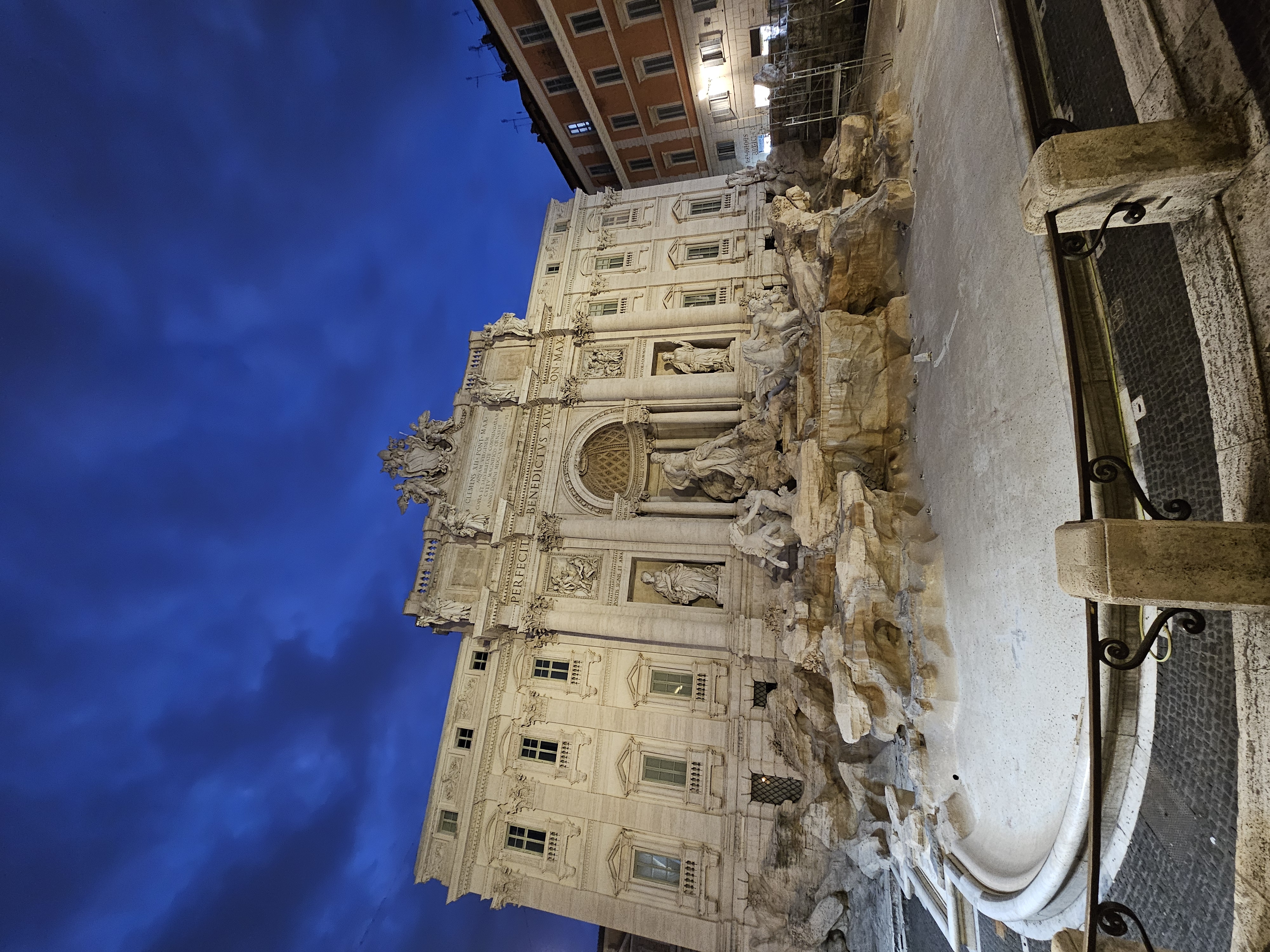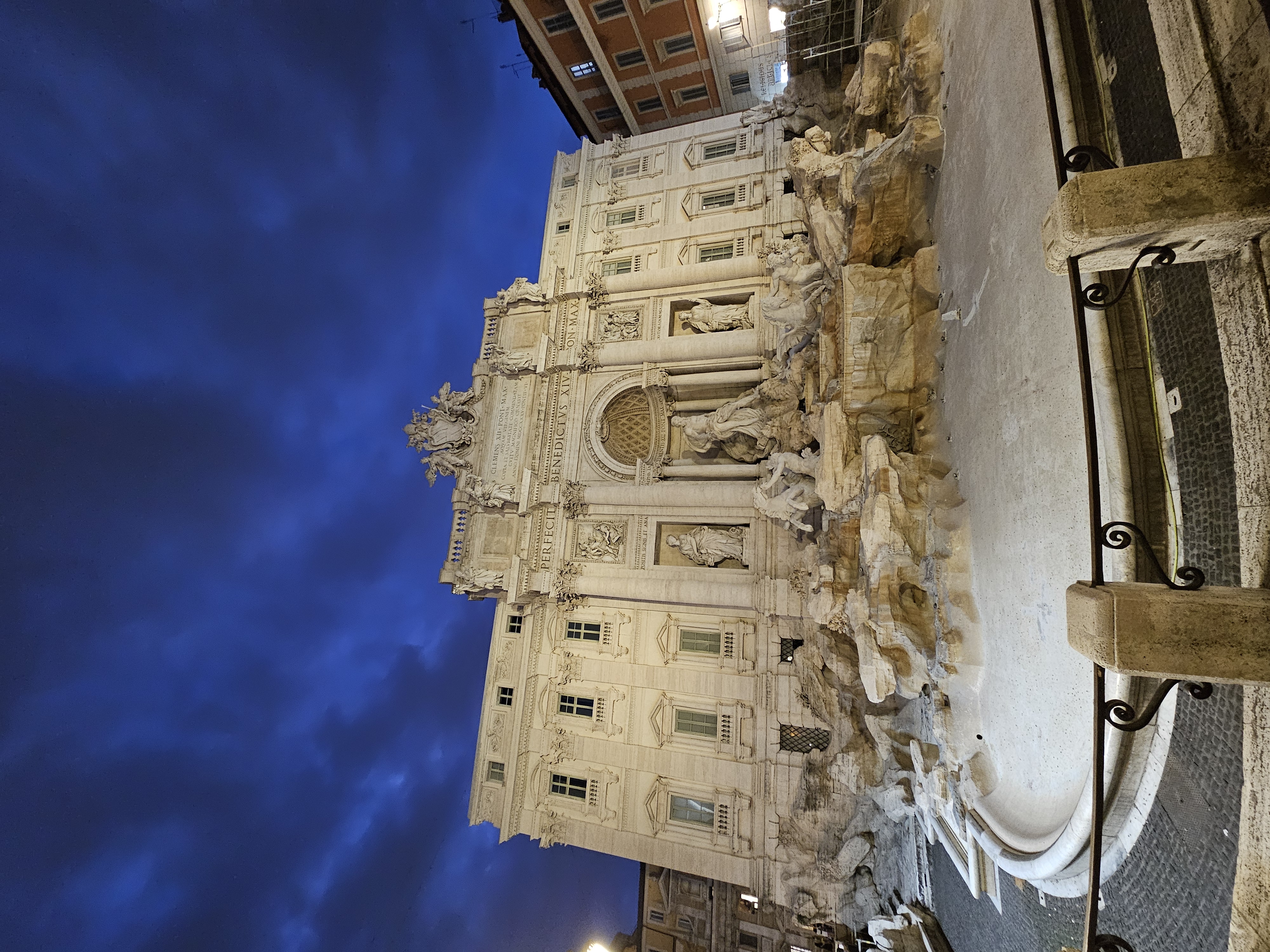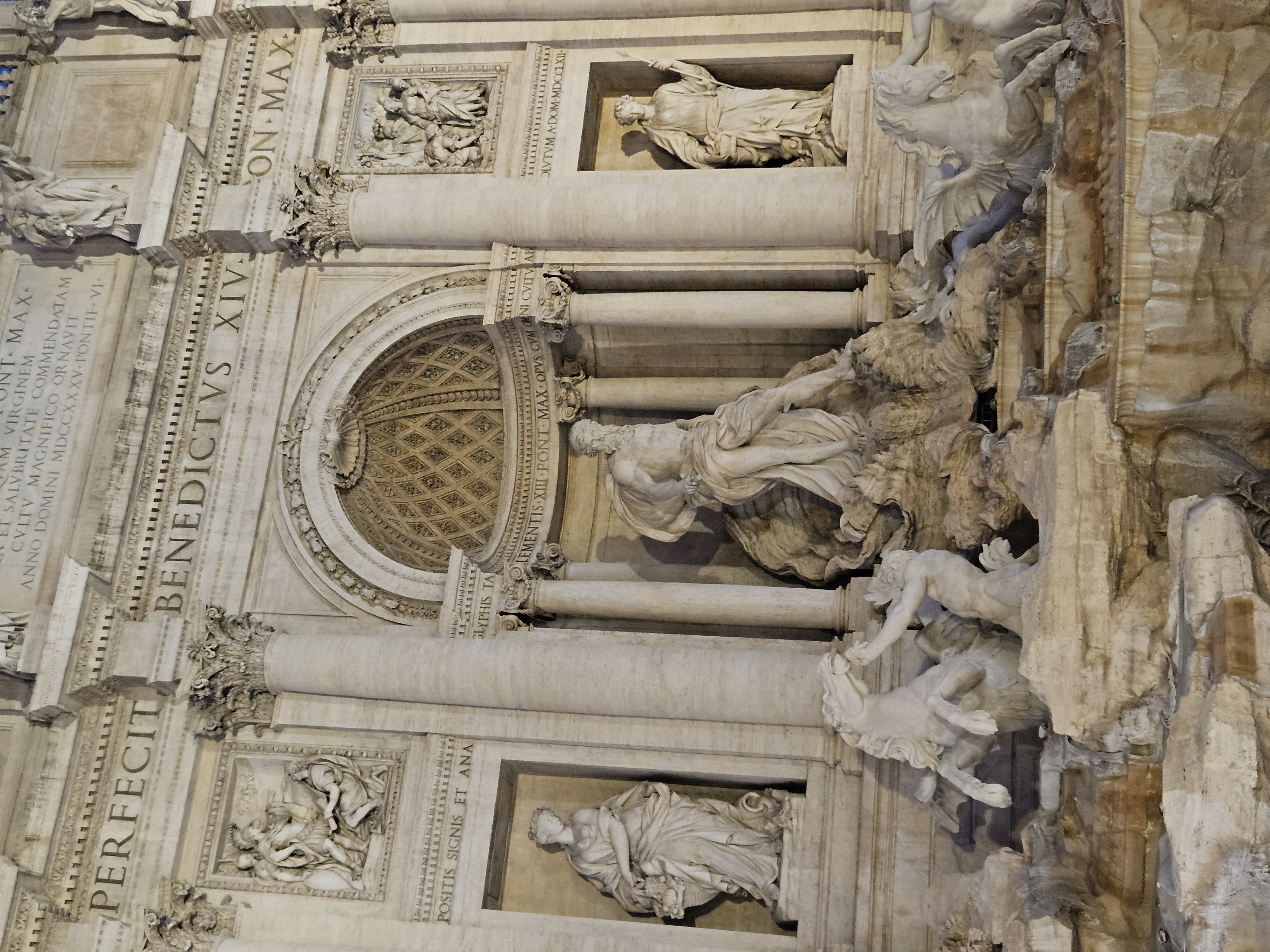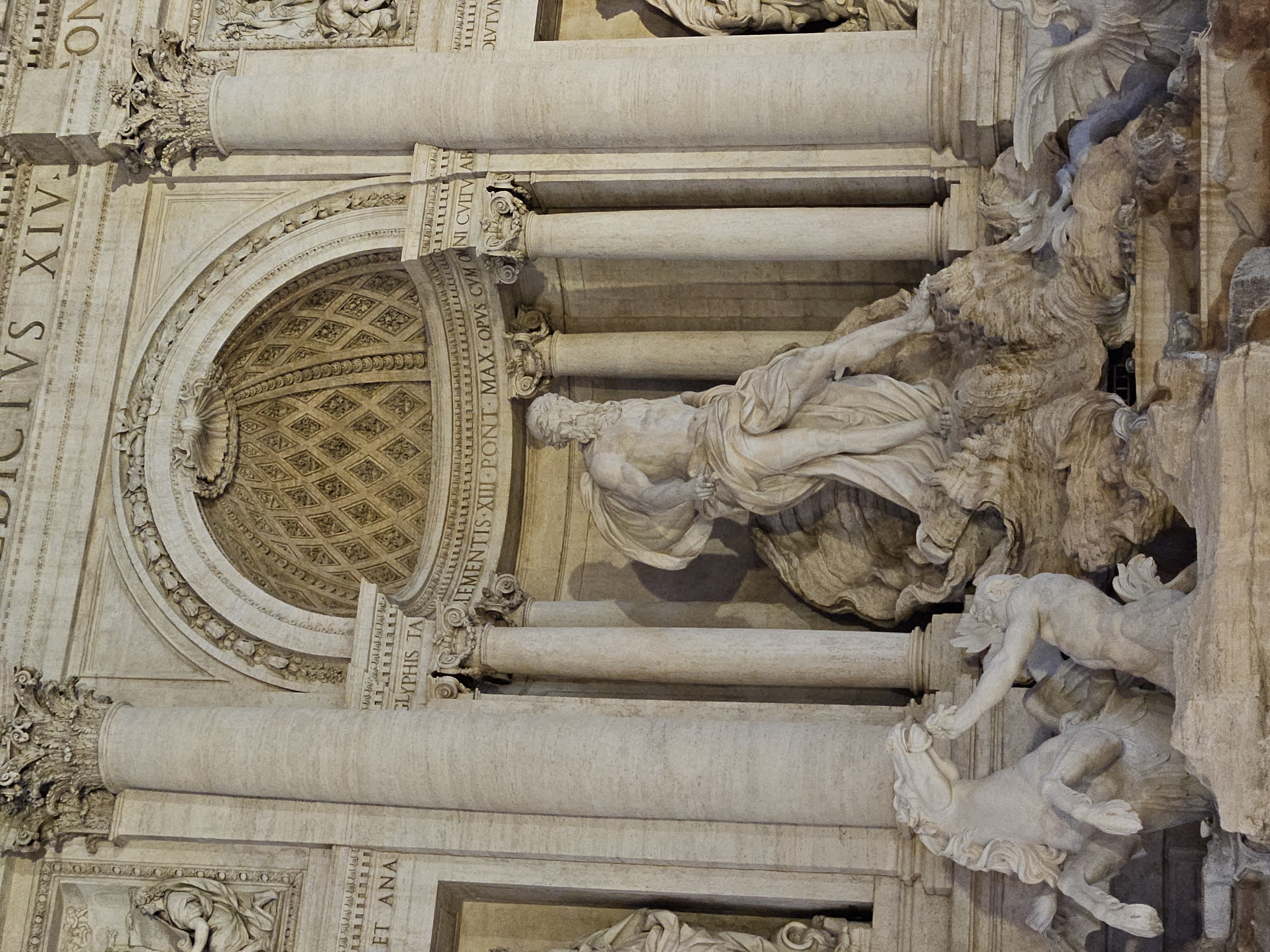We continue with Roman architecture. This is another building that it would be a waste not to visit while we are in Rome. The Trevi Fountain is also one of the most famous Roman buildings. Unfortunately, the fountain was not working during our stay, but I found out that it has recently been put back into use, i.e. it is working. Although it was not working when we came to visit it, there were many people, everyone was throwing coins into it, in order for their wish to come true, so I had to try that myth too, I'll let you know when it comes true for me :D
Let's now take a tour of the fountain and listen to its history, I hope you like it, believe me, if it looks nice in the photos, it is 100 times more beautiful in person and is worth visiting, it is worth visiting the whole of Rome.

The Trevi Fountain, one of the most recognizable places in Rome, is a true icon of Italian art and architecture. This imposing baroque fountain is located in a small square, Piazza di Trevi, which has become an unmissable destination for tourists from all over the world. The fountain was designed by the architect Nicola Salvi, and was completed in 1762, during the papacy of Clement XIII.
At first, it attracts attention with its monumentality and wealth of details. At its center is the god Poseidon, shown driving his strange, dark horses, which symbolize the calm sea and wild waves. Below him are two servants, one holding a bag of seafood and the other on a dolphin – all together representing the wealth and power of the sea. In the background of the fountain, you can notice the opulent facade of the Poli Palace, which further adds to the grandeur and elegance of this unique building.

The Trevi Fountain is more than a work of art; it is actually part of the Roman waters, because it connects the aqueduct that was created in the ancient period. It is believed that any visitor who throws a coin into the fountain is sure to return to Rome one day, and according to some legends, the number of coins that people throw each year can be more than 3 million euros. This money is used for charity, making the fountain not only a symbol of wishes, but also of solidarity.
For me, as for many, the Trevi Fountain is not just a place to visit for photos. It's that special point on the map, where the sound of the waterfall, the magical atmosphere and the ever-present crowd create an unforgettable experience. Whether you are at that moment with friends or alone, you have the impression that you are part of something big - not only in terms of the history of Rome, but also the very energy that this fountain carries.

The Trevi Fountain, as we mentioned, is not only a masterpiece of Baroque architecture, but also a key element in the history of Rome's water infrastructure. Its origin is connected with the need for water, which in Rome was of essential importance, both for everyday life and for imperial power. The aqueduct "Acqua Vergine," which supplies the fountain, was built as early as 19 BC under the emperor Augustus, and has supplied Roman citizens with water ever since. The name of the aqueduct comes from the Latin word "virgo" (maiden), because, according to legend, a young girl from Rome first showed herself to the Roman leaders, showing them the source of clean water, which later became crucial for the city.

However, the fountain as we know it today was not originally intended. In the 15th century, Pope Nicholas V ordered the marking and improvement of the water source, and later, during the papacy of Clement XII, a project was initiated to build a monumental fountain. In 1732, the Pope organized a competition among architects to design a fountain, and the work was entrusted to Nicola Salvi. His project was extremely ambitious and envisioned not only an artistic expression, but also a perfect connection with the surrounding buildings.

Salvi had the help of the experienced sculptor Giovani Paolo Pannini, who helped to realize the central part of the composition. The artist Luigi Vanvitelli also participated in the creation of the fountain to a large extent, and the work on the fountain lasted for 30 years, given that it was completed only in 1762, posthumously. The Trevi Fountain is one of the most beautiful Baroque works, in which Salvi brilliantly combined the elements of antiquity and the Renaissance, creating a dynamic scene, where Poseidon is shown in motion, controlling his colors.
Throwing a coin into the fountain became part of the tradition many years later, but very quickly it took on its own meaning. At first, visitors threw coins with the wish to return to Rome, but the beliefs developed and spread to this day. Tossing a coin symbolizes an act of hope, desire and reconciliation with one's destiny. Moreover, the whole tradition received considerable confirmation during the 20th century, when it became almost inevitable that anyone visiting Rome should not throw a coin into the fountain. Although a similar practice exists today in many places around the world, no fountain is as strongly associated with that ritual as the Trevi.

The fountain has also undergone several significant restorations, the last of which was in 2015, when a huge renovation was undertaken, financed in part by the fashion house Fendi. During this restoration, the fountain was thoroughly cleaned and restored, returning it to the splendor of when it was newly built. During the restoration, the sculptures were thoroughly cleaned of sediment and impurities accumulated over the centuries, and the entire structure was refreshed.
What makes the Trevi Fountain special is not only its size, artistic details and historical significance, but also the fact that it has become a meeting place for all peoples. Visitors from all over the world come to see this monumental structure, who, as if in a kind of trance, admire its beauty. And for everyone, regardless of language, culture or origin, Trevi is a symbol of hope, return and dreams. Sometimes, at the moment when the sun is setting and the water of the fountain is sparkling, we feel that we are standing in front of something much bigger than the architecture itself — in front of a work of art that has survived the centuries, carrying with it everything that Rome stands for.
Congratulations @sniki003! Your post brought a smile to the TravelFeed team so we have sent you a smiley. Keep up the good job. 🙂
Thanks for using TravelFeed!
@for91days (TravelFeed team)
PS: Did you know that we have our own Hive frontend at TravelFeed.com? For your next travel post, log in to TravelFeed with Hive Keychain or Hivesigner and take advantage of our exclusive features for travel bloggers.
Congratulations, your post has been added to the TravelFeed Map! 🎉🥳🌴
Did you know you have your own profile map?
And every post has their own map too!
Want to have your post on the map too?
- Go to TravelFeed Map
- Click the create pin button
- Drag the marker to where your post should be. Zoom in if needed or use the search bar (top right).
- Copy and paste the generated code in your post (any Hive frontend)
- Or login with Hive Keychain or Hivesigner and click "create post" to post to Hive directly from TravelFeed
- Congrats, your post is now on the map!
PS: You can import your previous Pinmapple posts to the TravelFeed map.Opt Out
You can check out this post and your own profile on the map. Be part of the Worldmappin Community and join our Discord Channel to get in touch with other travelers, ask questions or just be updated on our latest features.
I've always wanted to see the Trevi!